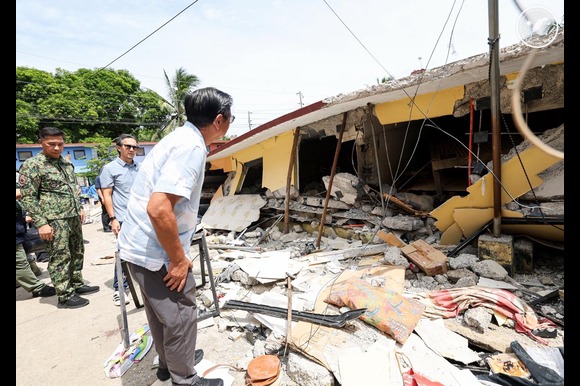
By Presidential Communications Office
A massive 7.4-magnitude earthquake struck off the southern coast of the Philippines early Friday morning, prompting urgent tsunami warnings across the Philippines and parts of Indonesia. Authorities urged residents in coastal areas to evacuate immediately amid fears of waves exceeding one meter (3.3 feet) above normal tide levels.
At least one person was killed, and several others were injured as strong tremors caused widespread panic, power outages, and the suspension of classes in several provinces.
Scenes of Panic in Davao as Buildings Shake and Patients Rush Outdoors
In Davao City, near the quake’s epicenter, scenes of chaos unfolded outside hospitals as patients were treated outdoors in parking areas. Witnesses described how vehicles stopped abruptly and overhead power lines swayed violently when the quake struck.
“Some buildings were reported to have been damaged,” said Edwin Jubahib, governor of Davao Oriental province. “It was very strong,” he told Philippine broadcaster DZMM, adding that emergency crews were assessing structural damage in several towns.
Local disaster official Richie Diuyen from the town of Manay said many students fainted from fear. “I am still scared and shook. We couldn’t believe how strong the earthquake was,” she told the BBC, calling it the most intense tremor she had ever experienced.
Aftershocks and Tsunami Alerts Shake the Region
The Philippine Institute of Volcanology and Seismology (Phivolcs) reported a series of aftershocks ranging from magnitude 2.6 to 4.9 in the hours following the main quake. Although the Pacific Tsunami Warning Center (PTWC) in Hawaii declared the tsunami threat over within an hour, Philippine officials urged continued vigilance.
In Indonesia, the Talaud Islands in North Sulawesi recorded “minor tsunamis” with waves up to 17 centimeters high. Local authorities sent students home and advised residents to stay clear of damaged buildings, though the situation there remained calm.
Nation Weary from Consecutive Disasters
This latest quake comes just a week after a 6.9-magnitude earthquake devastated Cebu province, killing 74 people and displacing nearly 80,000 residents. The Philippines, sitting squarely on the Pacific “Ring of Fire”, is among the world’s most disaster-prone nations.
“Filipinos are now experiencing disaster fatigue from typhoons, volcanic eruptions, and earthquakes,” said Dr. Teresito Bacolcol, director of Phivolcs. He urged citizens to “accept our reality” and focus on preparedness rather than panic.
Last month, the country’s north was battered by a super typhoon that killed 11 people and caused widespread flooding.
Authorities Urge Preparedness Amid Ongoing Risks
Emergency response teams have been deployed to assess damage and assist evacuees in affected regions. Authorities are also monitoring for potential landslides, especially in mountainous areas of Mindanao.
Dr. Bacolcol reiterated the need for public awareness and earthquake drills, stressing that the Philippines will continue to face frequent natural hazards.
“Every now and then, we will be jolted by earthquakes, volcanic eruptions, and tsunamis,” he said. “Instead of panicking, we have to prepare.”




